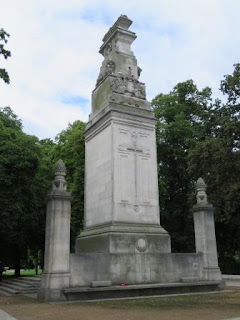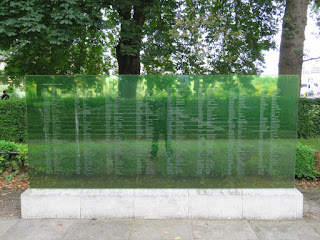The surnames of Titheradge, Hine and Emblin
 |
| Kingston Cemetery - Brambles Plot Titheradge family grave on the very back row |
George and Elizabeth Emblin
George
Emblin was a naval man who resided in Portsea in 1841. George had married
Elizabeth Harrow in Stoke Dameral, Devon in January 1813. On the 1841 census
George and Elizabeth had seven children, including two girls Sarah and Emma.
Sarah was baptised on 6 March 1825 in Portsea St Mary and Emma was baptised 30
January 1827 in Portsea St John.
Sarah Isabella Emblin
The eldest sister, Sarah, married in
Alverstoke, Hampshire on 13 January 1848. She married George Robert Titheradge, an accountant and son of Christopher
Titheradge. George and Sarah had 8 children born between 1848 and 1864. The children were
• George Sutton Titheradge born 1848
died 1916 in Australia (George became a famous actor)
• Ernest Montague Titheradgen born 1850 died 1851
aged 1
• Augustus Fabian Titheradge born 1852 died 1877
aged 25
• Sarah Ann Elizabeth Adela Titheradge
born 1853, married Frederick Watts
• Blanche Titheradge born 1857, married
George Watts
• Herbert Hine Titheradge born 1
December 1859 died 1926, married Emma Watts
• Annie Ada Titheradge born 1862
• Robert Titheradge born 1864 died as
an infant in1864
Sarah
died in the June quarter of 1864 either in childbirth or shortly after
childbirth. In 1867 George remarried to Sarah Perren.
One
thing that struck me was the very distinctive names given to some of the
children and the use of Sutton, Montague, Fabian and Hine as middle name. I
knew Sutton was the surname of their paternal grandmother, Martha Sutton and that
Fabian was surname of paternal great grandmother, Mary Fabian, but I had no
idea about Montague and Hine. The origin of the name Hine came from unexpected
source as you will see.
One other unusual thing is that 3 of the siblings, Herbert, Blanche and Sarah (known as
Adela), married into the Watts family of Bungay in Suffolk.
Emma Emblin
Sarah’s
younger sister, Emma, married four years later when she was 25. Emma married
Thomas Merit Hine, a gunner in the Royal Navy, on 25 October 1852 at Portsea,
St Mary. Emma and Thomas had 6 children born between 1852 and 1866. The
children were
• William Hine born 1852
• Montague Hine born 1857
• Herbert Titheradge Hine birth
registered Jan 1860
• Ada Hine born 1862
• George Martin Hine born 1864
• Henry (or Harry) Augustus Hine born
1866
Emma
lived until 1902 and died at the age 75 at The Yorkshire Grey public
house Portsmouth where she and Thomas were living with their son Herbert, the
proprietor of the pub.
Two Herberts and the Unusual Use of Surnames
There
is a noticeable similarity in the names of the children of these two sisters,
both sisters use Montague, Herbert, Ada, George and Augustus.
More surprising
is the fact that when Sarah and Emma both had sons around December 1859 they
both gave their son the same first name, Herbert. More unusual is the fact that
each added a middle name that was the married surname of their sister. This is
certainly not something I’ve ever come across before
Hence
we have two cousins born very close together one called Herbert Hine Titheradge
and one called Herbert Titheradge Hine. Imagine the confusion for the
grandparents trying to differentiate the two grandsons!
Herbert Titheradge
Herbert Hine Titheradge worked as a tailor. He married in 20
November 1881 in Bungay, Suffolk to Emma Watts. They had 3 children Blanche
born 1889, Alice born 1892 and George Augustus born 1896. The first two
children were born in Maldon, Essex and the third child was born back in
Portsmouth. Herbert continued to live in Portsmouth until his death. He died
suddenly on 22 March 1926 in Portsmouth aged 66. Herbert is buried in the family grave in Kingston
Cemetery. The records show it is a brick grave in Brambles plot (row 1 grave 10
) and contains Herbert Hine died 1926
with 5 others - George Robert Titheradge
(Herbert’s father died 1871), Sarah Isabella (Herbert’s mother died 1864),
Augustus Fabian (Herbert’s brother died 1877), Robert (Herbert’s brother died
1864) and Emma (Herbert’s wife died 1936).
Herbert Hine
Herbert
Titheradge Hine was in the navy and worked as a ships steward. Herbert married
Maria Laura Bond in 1884 in Portsea. They had eight children. In later life Herbert worked as a Hotel
proprietor. Herbert died on 2 May 1932 age 72 in Portsea. The
family continued to use the surname Titheradge as a middle name for at least
one of their children Leslie Titheradge Hine born and died in1889.
Please
get in touch if you can add any more to the story.
































